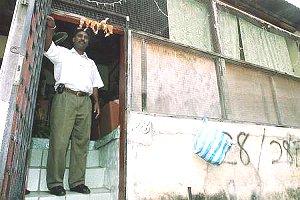Access to cheap homes still a factor
Sunday Star 12/9/2004
To ensure the well-being of the rakyat, the
Government has strived to improve access to affordable homes in
Budget 2005. Providing housing for the poor, however, involves more
than increasing the supply of low-cost homes, reports IVY SOON.
A. GANESAN and his family moved to their longhouse
in Pantai Dalam the year his youngest son was born. With only two
bedrooms, the house was too cramped for the family of six. However,
they were supposed to stay in the longhouse temporarily while
waiting to be relocated to low-cost homes.
His son is now 14 years old, having grown up in
the longhouse “where there are no proper playgrounds” for children.
“I have not been offered any low-cost home. There
was talk about relocating us to built-for-rent flats, but I have not
received anything official,” said Ganesan, 45, a pub worker.
Longhouses were first built in the 1980s as
temporary housing for families evicted from squatter settlements.
There are about 50,000 longhouse residents in
Selangor and Kuala Lumpur who are still waiting to move into
low-cost homes. Meant as temporary dwellings, the longhouses are
usually shoddily constructed.
In Budget 2005, the Government has expressed
concern about low-income groups living in transit houses.
Apart from allocations in housing projects, the
Government is planning to accelerate the construction of affordable
houses through “privatisation of government land through tender,
where the private developer will construct such homes in
consideration for the right to develop the land.”
As a pilot project, the Government will tender out
the implementation of an integrated development in Pantai Dalam,
Kuala Lumpur, where 1,000 households are still living in temporary
longhouses.
Ganesan said he had not heard of the proposed
pilot project in his area, and did not know if he would benefit from
the proposed initiative.
“Hopefully, someone could let us know about the
project. There must be a better way of getting information to the
people.
“Authorities have to take the initiative to go
from door-to-door, instead of setting up a counter somewhere.
“Residents often do not even know of these
services,” he said.
Under the Budget, the Government has allocated
RM778mil for the construction of 21,000 units of low-cost houses
under Projek Perumahan Rakyat for squatters in Kuala Lumpur
and other major towns.
The state governments will be provided with an
additional RM177mil in loans for the construction of 3000 units of
houses under Projek Perumahan Awam Kos Rendah.
“Allocating funds to support the construction of
low-cost homes has been done in past years. However, it is also time
the Government look at the situation on the ground, and examine how
they can ensure that poor people can afford to buy these low-cost
houses,” said Persatuan Masyarakat Wilayah Persekutuan and Selangor
(Permas) president Tan Jo Hann, who has been working with the urban
poor to solve their housing woes.
 |
|
LONG WAIT: Ganesan and his family have
waited 14 years to move out of their longhouse in Pantai
Dalam.
|
A low-cost flat costs RM35,000 in Selangor and
RM42,000 in Kuala Lumpur.
Although Ganesan is paying RM45 rental for his
longhouse now, he said he would be able to service the loan if he is
offered a low-cost unit.
“I would find it difficult to come up with the
deposit because of the big amount,” said the sole breadwinner who
has four school-going children.
Tan adds: “Instead of allocating funds to help
developers cope with rising costs, the Government should look into
establishing a revolving fund to help people buy homes. Selangor's
Ehsan Housing Fund (TPE) is a strategy that should be expanded
nationwide.”
Under Selangor’s TPE scheme, those who have been
offered low-cost units can get a full housing loan with only a RM1
deposit.
The loans are guaranteed by the state government
which has placed RM100mil in fixed deposit for 10 years with a
commercial bank. With this scheme, Selangor’s poor would be able to
own a low-cost home without worrying about the required 10%
deposit.
Tan acknowledged that the Government has good
intentions in helping the poor own homes.
“Apart from building more low-cost units, the
Government has also reviewed the eligibility criteria earlier this
year to enable more people to own homes.
“Implementation is the big issue,” said Tan.
“The Government leaves it to the developer to
build low-cost units, but someone must ensure that the people’s
welfare is not neglected.
“The Government should remain as project holders
to ensure the quality of the houses are up to standard.
“Now, buyers have to spend money renovating their
low-cost units because of the shoddy workmanship.”
Earlier this year, Selangor Mentri Besar Datuk
Seri Dr Mohd Khir Toyo proposed that those from the high and
medium-income groups be allowed to buy low-cost units to rent them
out to the poor to resolve the large number of unsold units in the
state.
From 1995 to March this year, 153,000 applied for
low-cost flats in Selangor.
One of the main grouses is the location of
low-cost housing. Sometimes, these flats are located far from main
roads, with no access to public transportation.
People have problems going to work and sending
their children to school. The poor cannot afford the additional
transport costs.
"For instance, squatters from Sg Besi (Kuala
Lumpur) had been resettled in flats in Taman Wahyu (Jinjang, Kuala
Lumpur) which is far from their previous homes.
“But in the meantime, about 200 longhouse families
living in the vicinity of Taman Wahyu cannot move there, and are
still waiting to be relocated," said Tan.
Other measures that have been proposed to help the
poor own homes include a rent-to-buy scheme that allows tenants of
low-cost properties to own their homes after a certain period,
getting state agencies to buy unsold low-cost houses to be rented
out, and helping buyers to get end-financing.
|